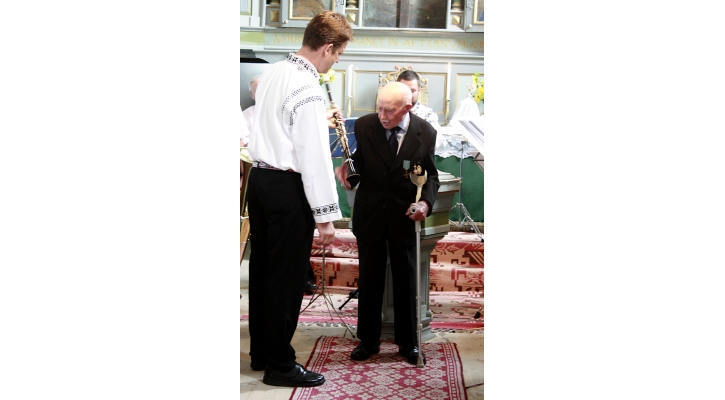The Last Saxon
For one uncommon day, the village of Meschendorf saw an influx of Saxons again as around forty previous residents of Meschendorf returned to the village for a very special celebration.

The local community celebrating Mr. Martin Werner. Photo by Ana A. Negru
On the 8th August 2010, they were attending the 100th birthday festivities of Martin Werner, one of the three remaining Saxons in the village.
Martin Werner was born a century ago in Meschendorf and has lived there for most of his life. He had a “content” childhood; h especially remembers Sundays with fondness as, being Catholic, no one in the village worked. Instead, after Church, the villagers would gather on the benches outside their homes to sit and talk and watch the young people dance to music played by the local Fanfare band (a group of men who played music of German origin with wind instruments, such as the trumpet and trombone). Mr Werner was a member of the band for fifty years and played the clarinet. As well as his happy childhood the best part of Mr Werner’s life was the few years after he married in 1934. His wife, unfortunately, died twenty years ago, but they had a long and happy marriage.
However, Mr Werner’s life hasn’t always been easy; he has lived through two world wars, communism and the mass exodus of Saxons from Romania in the 80’s. Martin Werner is a decorated veteran but he was also left with another souvenir from the Second World War; a severe shoulder injury. He was also taken prisoner during the Second World War; and he was incarcerated in Timisoara prison camp for three months. However he was released and made it back to Meschendorf.
Perhaps the constant in Werner’s life has been the Church. He was baptized, confirmed and married in Meschendorf church. He was also the caretaker of the church and a tour guide until five years ago.
The Church itself has seen its fair share of drama. It was built in the sixteenth century in the early gothic style; it is also fortified like the majority of Saxon churches. During its life it has had its walls knocked down and rebuilt and stood through three earthquakes. In one of them in 1700 the spire of the church broke and inside the original deeds to the church were found. A ceremony has since been held to place the deeds back in their original hiding place. In 2004 the Church had its walls and roof repaired by the Prince Charles’s Trust which helps maintain traditional buildings in Romania.
It was at the church that the celebrations for Mr Werner’s birthday started. He sat outside in the just emerging sunshine to welcome guests young and old, dressed in traditional dress and modern fashions. Martin Werner is a small man, bowed by age, but he has a powerful personality and a strong voice. He was dressed smartly in a black suit with his medals on display.
The church service was in German. A German choir interspersed the service with songs sung acapella and occasionally accompanied by the organ. Their voices fitted the church service perfectly; you could imagine hearing their singing in the church eight hundred years ago. The Fanfare also played several songs, the members dressed in traditional Saxon dress. Mr Werner remained standing the whole time they performed; it seemed to be a point of honour to him. He was presented with several gifts and eventually made a speech of thanks, reducing several people to tears. After the service the guests made their way to an orchard behind the church where several long tables had been laid. They enjoyed a traditional Saxon meal sitting under the shade of the apple trees.
The pleasant gathering was however tinted with sadness; the plight of Saxons in Meschendorf is a microcosm of their plight in Transylvania. The population in Meschendorf used to be 80% Saxon; now there are only three left. This is similar all over Transylvania. The Saxons first settled in Romania eight hundred years ago, and they thrived: their architecture can still be seen throughout the country with the traditional low, brightly painted houses and the many fortified churches.
They started to leave the country during the Second World War when several families were separated, some being in Germany and some in Romania. When the war ended in 1945 there was an agricultural reform, the consequences of which were that all Saxon villages were populated by Romanian colonists coming from other parts of the country. The Saxon people had to share their homes with the Romanian families. Mr Werner said this made them feel like subtenants in their own homes. The Saxons got their houses back in 1952 but there was still a lot of discrimination against them because they were seen as Nazis. Several left during these years but it was in the 80’s because of Communism and Romanian Nationalism that the Saxons left in mass, many leaving the only home they’d ever known. Mr Werner was one of the few who stayed behind, as at eighty he felt there was no point uprooting himself.
Now many Saxons only visit Romania for their holidays. One party guest, who used to live in Meschendorf explains that they have established a life for themselves in Germany, they have got used to the standard of living there and are settled. “It is sad,” he explains. “But Meschendorf is for the past.”
At least, for one day only, Meschendorf once again rang to the sound of German voices and the music of the Fanfare, and Mr Werner was reunited with his fellow Saxons, hopefully not for the last time in his long life.
by Victoria Richman
Photos: Ana A. Negru








